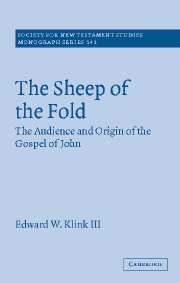
-
Select format
-
- Publisher:
- Cambridge University Press
- Publication date:
- September 2009
- August 2007
- ISBN:
- 9780511488023
- 9780521875820
- 9780521130448
- Dimensions:
- (216 x 138 mm)
- Weight & Pages:
- 0.57kg, 334 Pages
- Dimensions:
- (216 x 140 mm)
- Weight & Pages:
- 0.43kg, 336 Pages
You may already have access via personal or institutional login
Book description
The last generation of gospel scholarship has considered the reconstruction and analysis of the audience behind the gospels as paradigmatic. The key hermeneutical template for reading the gospels has been the quest for the community that each gospel represents. This scholarly consensus regarding the audience of the gospels has been reconsidered. Using as a test case one of the most entrenched gospels, Edward Klink explores the evidence for the audience behind the Gospel of John. This study challenges the prevailing gospel paradigm by examining the community construct and its functional potential in early Christianity, the appropriation of a gospel text and J. L. Martyn's two-level reading of John, and the implied reader located within the narrative. The study concludes by proposing a more appropriate audience model for reading John, as well as some implications for the function of the gospel in early Christianity.
Reviews
Review of the hardback:'This splendid volume is an important contribution to the new discussion of the audiences of the New Testament Gospels, and the first lengthy treatment of the audience of the Fourth Gospel from the vantage point of that discussion.'
Source: Biblica
Contents
Metrics
Altmetric attention score
Full text views
Full text views help Loading metrics...
Loading metrics...
* Views captured on Cambridge Core between #date#. This data will be updated every 24 hours.
Usage data cannot currently be displayed.
Accessibility standard: Unknown
Why this information is here
This section outlines the accessibility features of this content - including support for screen readers, full keyboard navigation and high-contrast display options. This may not be relevant for you.
Accessibility Information
Accessibility compliance for the PDF of this book is currently unknown and may be updated in the future.


